|
Message #3
Monday March 22 Yesterday, I forgot to mention our safety drill, which was quite interesting. We were told about all of the alarm signals for fire, abandon ship, man overboard, etc., and then practiced getting into our bright orange survival suits. They are quite bulky (one size fits all), and cover everything except the eyes and nose. Apparently it is possible to stay alive in waters as cold as these (0 to -1 degrees C) for up to 24 hours in one of these. We also all got into the lifeboat, which is a large orange boat with a cover - it holds up to 44 people. We crawled in through a hatch door, and strapped ourselves in facing each other. It's a self-righting boat, so no matter how bad the seas, it will stay floating. There are also some emergency life rafts which will automatically release when the ship is under water, but they would provide much less protection from the weather. Once a week there will be a drill of emergency procedures. When the alarms sound, we have to rush to the muster area carrying our survival suits, and then proceed up to the lifeboats. Everyone takes these exercises very seriously, and for good reason. This is a very hostile environment.
2000 hrs. We're at 54 54.149S 64 58.057W. That should be just at the tip of South America. We can still see land, but that will be it for several days as we cross Drakes Passage. The seas are already kicking up, and it is getting hard to walk or do much of anything. Walking is quite an effort in rough seas like these. You tend to bounce sideways off the walls of the hallways as if you are drunk. The hallways all have hand rails, and for good reason, as it is not possible to walk without being pitched back and forth. Walking itself is hard, since the steps you take are either very light as if you are weightless or they feel as if several hundred pounds are coming down with your foot. It is quite comical to watch, though a bit awkward while you are doing it. We have to be especially careful on the stairs, which are quite steep anyway. At one point, the movement of the ship will push you against the stairs, and the next will try to push you out and away from them. We're moving around OK inside the ship, but are not allowed out on the main deck. Some simple things are surprisingly difficult to do - taking a shower, going to the toilet (especially for men), and even sleeping. I can see why hammocks might be better than the fixed bunks we have. I had to tuck my blankets in tightly to keep from falling out of bed with the motion. The weather map looks favorable for this crossing - there is a high pressure system coming in that should give us some clear weather. All that means is that the waves will be smaller than they might have been. They are still huge from my perspective. We do hear that it has been very windy at Palmer Station all week, and that may make it difficult for us to sample, since we want to work from small rubber boats called Zodiacs.
1500 hrs. Right now we're at 57 40S 64 59W. The crossing continues to be rough but bearable. A few hardy souls are out and about re-securing their equipment or working in the labs, but most everyone else is holed up in their bunks or their rooms. A couple of people are in the lounge watching a video. We were just able to get a microwave image of ice cover in the area. I'm attaching it as a file to this message. From what we hear, this is a "low ice" year, which is good from the standpoint of getting to our nearshore stations for sampling, but a bit disappointing because there will be fewer icebergs and such to look at. In the image, you can see the ice shelf in the Weddell Sea, as well as one huge iceberg that is probably the size of Connecticut - just to the east of the peninsula. I'm sure there are many smaller ones that don't show up with this type of image. I had to shrink the image and decrease its resolution to make the image small enough to be sent from the ship, so I hope the interesting features are still legible.
 We're heading into this region as well equipped as possible - we're in a new
research vessel capable of cutting through 4-5 feet of solid ice (though an
icebreaker can go through more than 10 feet), we have constant satellite images
of ice, twice daily weather maps, radar, radio communication, and much more. I
can't help but think of the extraordinary courage of the early explorers to this
region, who had none of these things. Anyone interested in reading an amazing
account of exploration in these waters should read "South" by Ernest Shackelton,
or any other accounts of the plight of the Endurance expedition. We will be
collecting samples in some of the places where those men were struggling just to
stay alive. We're heading into this region as well equipped as possible - we're in a new
research vessel capable of cutting through 4-5 feet of solid ice (though an
icebreaker can go through more than 10 feet), we have constant satellite images
of ice, twice daily weather maps, radar, radio communication, and much more. I
can't help but think of the extraordinary courage of the early explorers to this
region, who had none of these things. Anyone interested in reading an amazing
account of exploration in these waters should read "South" by Ernest Shackelton,
or any other accounts of the plight of the Endurance expedition. We will be
collecting samples in some of the places where those men were struggling just to
stay alive.
|
 1600 hrs. We're traveling south now, along the Argentine coast, which
is to our right. We had a school of dolphins visit us a short while ago - they
traveled right in front of the ship, surfing on the bow wave and crossing back
and forth while the ship cruised along. There must have been a couple dozen of
them, including some small ones. They disappeared as quickly as they appeared. We
then watched a number of albatrosses feeding near the boat. From afar they look
like seagulls, but when you look closely, they are much bigger, with wing-spans
of 5-6 feet. They were very graceful - gliding over the water without much wing
movement at all.
1600 hrs. We're traveling south now, along the Argentine coast, which
is to our right. We had a school of dolphins visit us a short while ago - they
traveled right in front of the ship, surfing on the bow wave and crossing back
and forth while the ship cruised along. There must have been a couple dozen of
them, including some small ones. They disappeared as quickly as they appeared. We
then watched a number of albatrosses feeding near the boat. From afar they look
like seagulls, but when you look closely, they are much bigger, with wing-spans
of 5-6 feet. They were very graceful - gliding over the water without much wing
movement at all. Tuesday March 23
Tuesday March 23